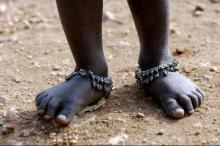The Feet & Pada Bandha
With twenty-six bones that form twenty-five joints, twenty muscles, and a variety of tendons and ligaments, the feet are certainly complex. This complexity is related to their role, which is to support the entire body with a dynamic foundation that allows us to stand, walk, run, and have stability and mobility in life. In yoga they are the principal foundation for all the standing poses and active in all inversions and arm balances, most back-bends and forward bends, and many twists and hip openers. Meanwhile they are also subjected to almost constant stress, ironically one of the greatest stresses today coming from a simple tool originally designed to protect them: shoes. Giving close attention to our feet—getting them strong, flexible, balanced, aligned, rooted, and resilient—is a basic starting point for building or guiding practically any yoga practice, including seated meditation.
In order to support the weight of the body, the tarsal and metatarsal bones are constructed into a series of arches. The familiar medial arch is one of two longitudinal arches (the other is called the lateral arch). Due to its height and the large number of small joints between its component parts, the medial arch is relatively more elastic than the other arches, gaining additional support from the tibialis posterior and peroneus longus muscles from above. The lateral arch possesses a special locking mechanism, allowing much more limited movement. In addition to the longitudinal arches, there are a series of transverse arches. At the posterior part of the metatarsals and the anterior part of the tarsus these arches are complete, but in the middle of the tarsus they present more the characters of half-domes, the concavities of which are directed inferiorly and medially, so that when the inner edges of the feet are placed together and the feet firmly rooted down, a complete tarsal dome is formed. When this action is combined with the awakening of the longitudinal arches, we create pada bandha, which is a key to stability in all standing poses (and a key source of mula bandha).
However, the feet do not stand alone, even in Tadasana, nor do they independently support movement. Activation of the feet begins in the legs as we run lines of energy from the top of our femur bones down through our feet. This creates a “rebounding effect.” Imagine the feeling of being heavier when riding up in an elevator, or lighter when riding down. The pressure of the elevator floor up against your feet not only makes you feel heavier, it has the effect of causing the muscles in your legs to engage more strongly. Similarly, when you intentionally root down from the tops of your thighbones down into your feet, the muscles in your calves and thighs engage. This not only creates the upward pull on the arches of pada bandha (primarily from the stirrup-like effect of activating the tibialis posterior and peroneus longusmuscles) but creates expansion through the joints and a sense of being more firmly grounded yet resilient in your feet while longer and lighter up through your body.
Teaching Pada Bandha
• Bring the class to standing with their feet together at the front of their mat.
• Ask them to look down at their feet and lift and spread their toes wide apart.
• Keeping the toes lifted, guide your students to feel the inner edges of the balls of their feet (about an inch in from the space between the big toe and the fourth toe) and to press that point more firmly down into the floor.
• Now ask students to repeatedly release the toes down and lift them up while keeping the inner edges of the balls of their feet rooting down, noticing how, with the toes lifted, the inner ankles and ankles automatically lift.
• Encourage the class to try to keep their inner arches and ankles lifted and to feel how this creates a sense of lifting the center of each foot like a pyramid, awakening pada bandha. The challenge arises in trying to maintain this awakening of the feet while allowing the toes to release softly down and spread into the floor.
• With pada bandha active, draw their attention to the rebounding effect, feeling the stronger activation of their leg muscles, awakening of their inner thighs, and lengthening up through their entire body.
